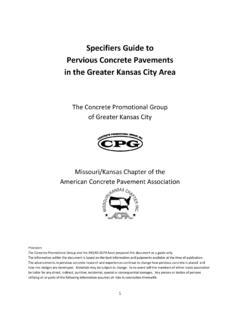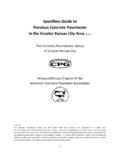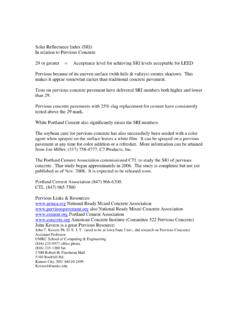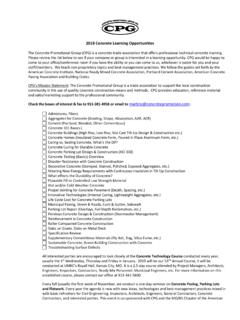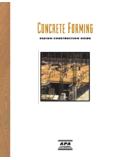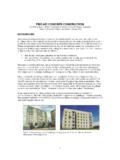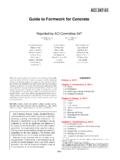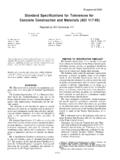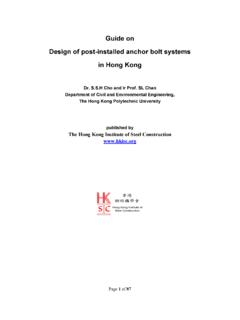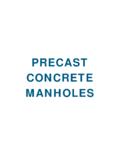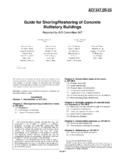Transcription of Specifiers Guide to Polished Concrete v1.2.13
1 1 Specifiers Guide to Polished Concrete in Greater Kansas City v. (June 2013) Provision: The Concrete Promotional Group has prepared this document as a Guide only. The information within the document is based on the best information and judgments available at the time of publication. The advancements in Polished Concrete research and experiences continue to change how Polished Concrete develops. In no event will the members of the trade association be liable for any direct, indirect, punitive, incidental, special or consequential damages. Any person or bodies of persons utilizing all or parts of the following information assumes all risks in connection therewith. 2 About Polished Concrete Polished Concrete is mechanically treated Concrete , treated with diamond grinding tools. Typically Polished Concrete is defined as treated with 800 grit up to 3,000 grit levels.
2 (Anything ground below 400 grit levels is not technically considered polishing.) Grinding tools are progressive pads building to the desired polish level. Polishing often includes using liquid hardeners and/or densifiers to add durability and serviceability to the surface. Colors and dyes can be used in conjunction with the Polished system to further enhance the aesthetics. There are other methods to meet client desires for a Polished Concrete look ; these other methods depend on the existing Concrete profile, the contractors experience and expertise, the equipment and the supplies used. Polished Concrete is not to be confused with stained Concrete , epoxy Concrete , terrazzo Concrete or sealed Concrete . Sealers or epoxies are applied over plain Concrete or stained Concrete . These sealers/epoxies can produce a flat finish or a high gloss finish. Polished Concrete is actually changing the surface of the Concrete physically by using pads, grits and buffing materials to achieve the finish mechanically.
3 Polishing Benefits A sustainable design flooring option. Uses materials already present. Eliminates the energy and additional materials to apply other flooring options such as carpet, wood, tile, etc. Low maintenance. More durable and easier to clean than many other flooring options. Increased slip resistance (vinyl composite tile (VCT) standards typically are a minimum of .5 SCOF, Polished Concrete is typically .7 to .9 SCOF). Reduces the opportunity for dust and dust mites for asthma and allergy suffers. Improves natural lighting with the reflective surface bouncing light around the room. Potentially reduces the need for additional interior lighting. Hard wearing surface has less opportunity for chipping, denting and wear and tear. Cleaner, healthier atmosphere for restaurants, hospitals and medical clinics, etc. Types New (construction of a new floor can have a huge effect on the final Polished product).
4 Retrofit (either with an overlay that is Polished or by cutting and sanding the existing floor). 3 Sustainability & Green Building Many current green building certification programs and construction guidelines for achieving green points or credits can be attained by using Polished Concrete . The reasons are listed above in the benefits section, , less energy use, more natural light, less construction materials needed, low maintenance, etc. Some examples of the programs are: LEED by the Green Building System, USGBC Green Building Standards, National Association of Home Builders, NAHB National Green Building Standard, International Code Council, ICC Green Globes, ECD Energy and Environment Canada Polished Concrete can achieve LEED NC credits: Materials & Resources (MR) Credit Building Reuse, Maintain 75% of Existing Walls, Floors and Roof. The intent is to extend the lifecycle of materials to prevent waste and reduce the environmental impact that is caused by harvesting and manufacturing new material.
5 Reusing the Concrete slab as part of the building helps to achieve this point if the total amount of reused materials in the project meets or exceeds 75% as calculated by square footage. Materials & Resources (MR) Credit Building Reuse, Maintain 95% of Existing Walls, Floors and Roof. The intent is the same as above in MR Credit except it must meet the criteria of 95% reuse of building materials on the project. Materials & Resources (MR) Credit Materials Reuse, 5% reused items. Polishing the slab instead of harvesting additional materials to cover the slab prevents waste and reduces the impact on the earth s finite resources. Reusing the slab as a finished floor, instead of covering it up with carpet, tile or other materials helps to meet this objective. Material & Resources (MR) Credit Material Reuse, 10% of reused items. If the amount of materials reused exceeds 5% and meets or exceeds 10% then this point can be attained in addition to MR Indoor Environmental Air Quality Low Emitting Materials, Paints and Coatings.
6 Indoor air quality effects the quality of life and well being of the occupants of a building considering the amount of time spent indoors at work, home or school. Materials that emit odors or VOCs (volatile organic compounds) should be eliminated. By using a low VOC or no VOC sealer on the Polished floor or by eliminating the sealer altogether, Polished Concrete can meet this requirement. Energy & Atmosphere (EA) P2 Minimum Energy Performance (Mandatory Prerequisite). All buildings must comply to a minimum energy efficiency level overall as established by the local building codes, the Dept. of Energy Standards or by complying with ASHRAE/IESNA 2004 regulations. The reflective nature of Polished Concrete reduces the amount of artificial light needed. This helps to maximize the natural and artificial lighting already in use, improving energy efficiency of the lighting system as a whole.
7 The insulation gained from the thermal 4 mass of constructing with Concrete , including walls and exposed slabs, used with passive solar design principals, helps retain the internal temperature of the building. Using thermal mass as a design element will moderate the daily temperature fluctuations and reduce the HVAC load. Energy & Atmosphere (EA) 1 Optimize Energy Performance 1 10 points. If the energy efficiency exceeds the energy savings required in the baseline in prerequisite EA P2, an additional ten points can be achieved through EA1. Polished Concrete can assist through increased ambient lighting and thermal mass for these items. 5 Glossary of Polished Concrete Terms (As established by the Concrete Polishing Association of America, Spring 2013 to create a common language between designers, constructors and the industry.) Polished Concrete - The act of changing a Concrete floor surface, with or without aggregate exposure, to achieve a specified level of gloss using one of the listed classifications; Bonded Abrasive Polished Concrete , Burnished Polished Concrete , or Hybrid Polished Concrete .
8 Bonded abrasive Polished Concrete - The multi-step operation of mechanically grinding, honing, and polishing a Concrete floor surface with bonded abrasives to cut a Concrete floor surface and to refine each cut to the maximum potential to achieve a specified level of finished gloss as defined by the CPAA. This yields the most durable finish and requires the least maintenance. Burnished Polished Concrete - The multi-step operation of mechanical friction-rubbing a Concrete floor surface with or without waxes or resins to achieve a specified level of finished gloss as defined by the CPAA. This operation yields a less durable finish and requires more maintenance than bonded abrasive Polished Concrete . Hybrid Polished Concrete - A multi-step operation, using either standard grinding / polishing equipment, lightweight equipment, high speed burnishing equipment, or a combination of, to combine the mechanical grinding, honing, and polishing process with the friction rubbing process by utilizing bonded abrasives, abrasive pads, or a combination of, to achieve the specified level of finished gloss as defined by the CPAA.
9 Surface coated Concrete - Surface coated Concrete does not conform to the definition of Polished Concrete per the CPAA. It is the operation of applying a film forming coating to a Concrete floor surface to achieve a specified level of finished gloss. Durability depends on the quality of the chemical coating used, the amount of traffic across the floor, and floor maintenance. Polishing Process - The steps required by a polishing technician to transform the Concrete substrate into a specified finished gloss. These steps may include a sequence of grits of bonded abrasives spanning the grinding, honing and polishing stages ( 70 grit metal bond, 120 grit metal bond, 50 grit hybrid bond, 100 grit hybrid bond, 200 grit resin bond, 400 grit resin bond, 800 grit resin bond, 1500 grit resin bond, 3000 grit resin bond). Grinding Stage - The steps of the polishing process that refines the Concrete in preparation for the honing stage.
10 This stage is typically the beginning for Class C and D specified floors and may meet the requirements for a level 1 specified gloss. This stage consists of any bonded abrasive that is 100 grit or lower. Honing Stage - The steps of the polishing process that refines the Concrete in preparation for the polishing stage. This stage can sometimes be the beginning steps for Class B specified floors and may meet the requirements for a level 2 specified gloss. This stage consists of diamond tooling within the 100-400 grit range. Polishing Stage - The final stages of the polishing process that refines the Concrete to the specified finished gloss levels 3 or 4. This stage consists of diamond tooling that is 800 grit or higher. Burnishing - The act of using a high speed burnisher affixed with an abrasive pad to further enhance the microscopic abrasion of the Concrete surface to increase the finished gloss.
